Syren for Port Jackson plied the waters of Sydney Harbour, delivering a unique location-sensitive, immersive audio experience aboard the M.V. Regal. The Syren project is part of the AudioNomad R+D project ~ a collaboration between the Artist Nigel Helyer and the Scientists Daniel Woo and Chris Rizos of the University of New South Wales.
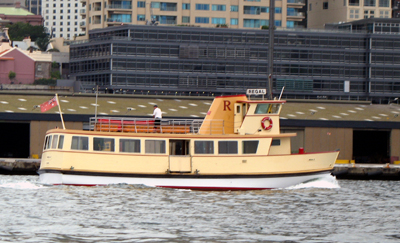
The Regal approaching Darling Harbour.
Download an AudioNomad PR blurb
Also check-out AudioNomad and Syren
For more information go to the AudioNomad website.
Syren for Port Jackson was a recent pilot project designed to demonstrate the potential of the AudioNomad systems that have been developed over the past two years. The original Syren project was mounted on the Helipad of the cruise liner “Opera” and toured the Baltic in 2004 as part of ISEA. The current work is a more sophisticated and accurate development, allowing the composition of finely-grained non-linear spatial compositions that provide an immersive user experience.
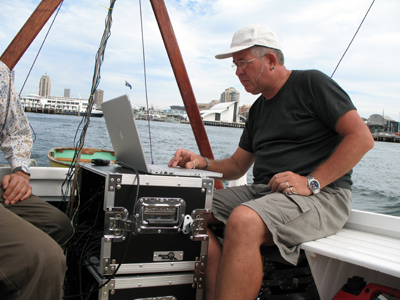
Composing on the fly aboard the test rig, Leander.
Working in our home city was a conceptual and compositional challenge as it was important to address a raft of historical and cultural material and situate the sonic material in the appropriate physical context. We used a small motor launch, the Leander as a test rig to de-bug both the software, the technical running gear and the compositional strategy.
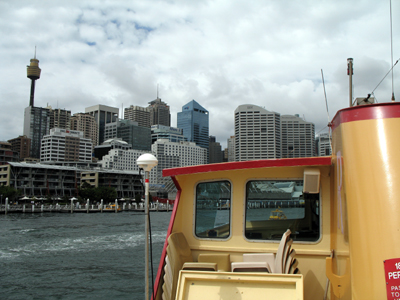
DGPS tracks the Regal with a 1 metre accuracy.
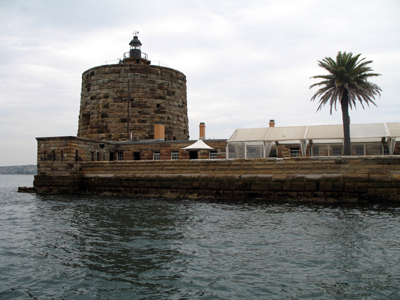
Listen to a couple of stereo samples from the project, again nothing like the multi-channel realtime spatially dynamic experience, but then you had to be there to be there!
The Sonic Nomadic: Exploring Mobile Surround-Sound Interactions – Co-founded by Helyer (creative director) and Woo (scientific director), AudioNomad is an art and science research program—a location-aware virtual and augmented audio-reality system. Its software allows a mobile user or vehicle to perform a soundscape. This article discusses some of the challenges in the development of three works: location-aware, surround-sound installations mounted on ships; mobile handheld devices for individual pedestrian use; and interactive surround-sound installations for static museum exhibitions.
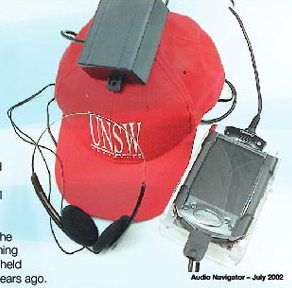
AudioNomad consists of a series of cross-disciplinary art and science projects working with the concept of GPS-driven, location-based audio applications. The project’s outcomes generally take the form of artworks (interactive installations and exhibits) that let a user or audience experience a virtual audio world. We intend such a world to be perceived as though it were situated within the real world so that the user experiences the synthetic sounds as seeming to originate from real objects.
We use 2D and 3D audio spatialisation to simulate realistically situated sound sources, and non-spatialised sound sources as location-based content. These sounds reveal information or create an aesthetic effect. In AudioNomad artworks, the content often entails a combination of oral histories, archival audio, local historical information, field recordings, and music related to the general area or specific locations. The outcome is a culturally significant, temporary artefact that relies on this location-based medium—an application consisting of global positioning, audio technologies, and software engineering.
Conceptual origins – There is a marvellous passage in Laurence Stern’s The Life and Opinions of Tristram Shandy, published between 1759 and 1767, that de- scribes a unique map, made on a one-to-one scale—that is, a map made to fit exactly over the physical features it represents.1 The Audio-Nomad research program operates a sonic cartography with characteristics that are similar to Stern’s one-to-one map, due to the vast scale of the geographic area available to the GPS-enabled system and the fact that the sound composition is performed by the mobile presence of the user traversing real geography.
Another literary source provided the impetus for developing a sonic cartography able to seed a physical environment with virtual audio memories. The storage and retrieval of audio content within a complex soundscape, virtually associated with real landscape objects, has its roots in a classical mnemonic system for storing rhetoric. In The Art of Memory, published in 1964, Frances Yates paints a vivid picture of the antique technique that enabled orators to place memory objects, such as lengthy quotations, within the labyrinthine spaces of classical architecture. By visualising an architectural interior, real or imaginary, the speaker might place a red cloak over a sculpture and a sword on a table as mnemonic triggers. By memorising a stroll through this virtual architecture, an orator could retrieve a vast amount of correctly sequenced rhetoric.
The AudioNomad project transmutes such imaginary architectural space into the cartographic space of a digital map—itself a representation of the physical site of the project—and develops a sonic landscape by assigning sound files, trajectories, and other properties at multiple locations within this virtual domain. Whereas the classical rhetorician would replay a walk through an imaginary architecture to retrieve the elements of a speech sequentially, the participants in an AudioNomad project walk in a real environment with their position and orientation driving the software soundscape, which is delivered to surround-enabled headphones.
In this context, users experience the soundscapes as immersive 3D spatialised sound. Audio events appear to be located at specific points in physical space, forming a seamless nexus between the real and the virtual. Thus, users experience a type of parallel audio world in which memories of particular sites are invoked alongside contemporary reality. Alternatively, the AudioNomad system can be successfully deployed to massive surround-speaker arrays on large mobile platforms, as in the case of the ship-mounted works Syren and Syren for Port Jackson. Or the system can be driven from a static museum interactive display.
Syren – is a shipboard version of augmented audio reality that allows passengers to link the multichannel surround-sound experience onboard with the visual experience of the surroundings. via a high-resolution GPS coupled to a digital compass, the system automatically accesses geospatial information as the ship navigates the electronic charts associated with the ship’s track. This positional information is used to render a surround-sound, 3D soundscape corresponding to proximate physical features.
Some Documentary material from Cathy Vogan (Vogania).
Syren made its debut on the passenger cruise ship Opera on the Baltic Sea as part of the Inter-national Symposium on Electronic Arts in August 2004. A further developed version, called Syren for Port Jackson, was run over three days in March 2006 (see Figure 2) in conjunction with the conference New Constellations: Art, Science, and Society at the Museum of Contemporary Art in Sydney.
These projects test concepts in virtual sound-scape design and compositional processes at a much larger scale than is possible with hand-held AudioNomad systems. Each maritime project is a specifically designed sonic seascape that positions sound content on or around various features of navigational and maritime structures. With special attention paid to local maritime narratives, histories, and specific elements of the local ecology and seascape, we interweave these components to form a unified sonic narrative derived from ancient epic voyages (as the title Syren implies) as well as from contemporary political and cultural life. The soundscapes include ambient and environmental sounds, various music and songs, as well as multilingual voice narratives drawn from archival and live recordings.
As the ship navigates through and around the harbours, the software calls up elements of the soundscape, rendering them in the appropriate direction and distance to simulate the real sound associated with the landscape and seascape features. One of the principal effects of Syren is to suggest a series of parallel audio realities that appear to overlay the visual landscape and seascape and open up the possibility of observing a cultural and historical axis pivoting on a geospatial point.
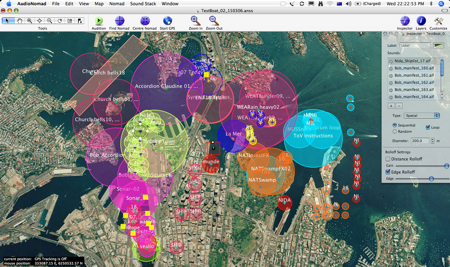
Conceptual and sonic challenges – Our principal compositional and design challenges have been working with perceptions of geospatial displacement, wherein distance and speed are transposed to volume and loudness, and the large scale of architectural, landscape, and seascape features.
In the Syren project, we place a strong emphasis on a highly imaginative and creative approach to sound composition and sound design to highlight the potential of this emergent field of geospatially located virtual audio. Unlike conventional sound design or musical composition, geospatially located audio needs to be highly sensitive to its environmental and architectural context as well as to the fundamentally nonlinear manner in which the user might interact with the content (in this case via the position, speed, and heading of the ship). Pedestrian projects also require consideration of the user’s behaviour and unpredictable interaction with
the content via position, speed, and heading in relation to the architectural and urban environment.
Conceptually and sonically, the principal challenge of the research is to develop a strategy to deliver a nonlinear but coherent field of audio. The system we created provides the possibility for both fixed and mobile audio events, as well as several mechanisms for sequencing sound files in several ways.
Another significant challenge is conceptualising sonic events in the mould of a topology, thus escaping the view of the world and of sound composition that is object-oriented to one that is relational and inextricably connected through spatial and temporal axes.
Narrative cartographies – Mapping Footprints, Lost Geographies in Australian Landscapes is a walk through a narrative-scape that overlays a landscape marked with geographical images engraved by the Aboriginal clans, custodians of Sydney’s northern countries before the European invasion. The site offers the visitor spectacular scenery of the surrounding bush from a rock platform. Part of the experience of engaging with the site resides in the search for the engravings, which are scattered over the terrain. Figures of local animals and mythological heroes reveal themselves to an attentive eye, as they are distinguished from the natural fissures in the ground.
Due to the dramatic effects of the European invasion, the meaning of the engravings and their specific cultural significance remain largely unknown. Hypotheses suggest they are teaching aids used to pass on local knowledge to the young through rituals and storytelling. The place’s character, topography, lost geographies, and supposed use in traditional times, as well as the characteristics of the medium employed to intervene on the site, inform the mapping strategies developed by the project.
An interactive sonic map, triggered by the walkers’ meanderings through the site, medi- ates the experience along the way. This is an immersive experience of seamless continuity between the real and the virtual. As the users engage with the narrative and the physical space, subjective dialogues unfold between the walkers and distant storytellers belonging to other places and times.
Due to the availability of wireless networks and GPS, the medium enables mobility, extending places to distant yet present spatiotemporal contexts. Hence the site is open to the encounter with virtual narrators who tell from their own experience stories of places, personal memories, and legends from all over Australia, challenging the abstract nature of maps.
Teleportation and other worlds – The third modality described here makes a break from the approach that seamlessly co-locates the soundscape with the landscape. We developed the recent Run Silent Run Deep project during a three-month artist-in-residence stay at the Tropical Marine Science Institute of the National University of Singapore. We exhibited the project at the National Museum of Singapore as part of the 2008 International Symposium of Electronic Arts. Taking an ironic twist on the wartime submariners’ motto, ‘‘run silent run deep,’’ the project maps an audio portrait of Singapore with a strong emphasis on discovering and amplifying the maritime life and marine biology of the island.
Visitors to the work explore a large data set of audio files via interaction with a cartographic interface displayed on a custom-built tabletop projection surface. A 12.2 speaker array renders a powerfully immersive soundscape in real-time, according to the position, orientation, and relative velocity of the users.
Once again, the user is at the centre of a sonic universe and is palpably in control and aware of both the spatial movement and the sonic developments. However, in this modality, there is an inevitable displacement between the real location of the participant and the provenance of the recorded material, recalling the schitzophonic nature of all recorded sounds. (Murray Schaeffer coined the term schizophonia to denote the dislocation of recorded audio from its source.
Thus, to a degree, the engagement with a museum-based static interface, spatially dislocated from the physical landscape features that its cartographic interface represents, produces a more abstract and subjective experience. The synergy is between the interrogation of a cartographic, representational space and the dynamics of a real-time composition that such navigation renders.
Conclusion – The construction and the experience of AudioNomad soundscapes occur simultaneously in temporal and spatial domains. While the experience of audio is by nature temporal and generally perceived as both continuous and linear, the experience of a spatially constructed soundscape is far less predictable. This situation is complicated by the nature of the content, which references a range of historical and contemporary material.
Although the works are inevitably spatially bound (albeit often on a geographically large scale) and might contain principal vectors (obvious routes or physical barriers), the compositional structure and strategy don’t impose a spatial hierarchy or even propose an explicit spatial structure. Spatiotemporal complexity is, for example, amplified by the pace of walking through the physical landscape and how the landscape meshes with the sound events, which can be fixed in absolute space, coupled to a trajectory, or positioned relative to the participants’ position.
While the AudioNomad compositional tool- set is relatively simple, in practice it’s able to produce an extraordinary level of sonic complexity, and, above all, associate multiple layers of sonic associations with a physical site, unlocking memories and fuelling the imagination.